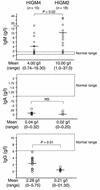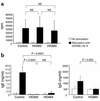Hyper-IgM syndrome type 4 with a B lymphocyte-intrinsic selective deficiency in Ig class-switch recombination
- PMID: 12840068
- PMCID: PMC162294
- DOI: 10.1172/JCI18161
Hyper-IgM syndrome type 4 with a B lymphocyte-intrinsic selective deficiency in Ig class-switch recombination
Abstract
Hyper-IgM syndrome (HIGM) is a heterogeneous condition characterized by impaired Ig class-switch recombination (CSR). The molecular defects that have so far been associated with this syndrome - which affect the CD40 ligand in HIGM type 1 (HIGM1), CD40 in HIGM3, and activation-induced cytidine deaminase (AID) in HIGM2 - do not account for all cases. We investigated the clinical and immunological characteristics of 15 patients with an unidentified form of HIGM. Although the clinical manifestations were similar to those observed in HIGM2, these patients exhibited a slightly milder HIGM syndrome with residual IgG production. We found that B cell CSR was intrinsically impaired. However, the generation of somatic hypermutations was observed in the variable region of the Ig heavy chain gene, as in control B lymphocytes. In vitro studies showed that the molecular defect responsible for this new HIGM entity (HIGM4) occurs downstream of the AID activity, as the AID gene was induced normally and AID-induced DNA double-strand breaks in the switch micro region of the Ig heavy chain locus were detected during CSR as normal. Thus, HIGM4 is probably the consequence of a selective defect either in a CSR-specific factor of the DNA repair machinery or in survival signals delivered to switched B cells.
Figures





Comment in
-
Novel antibody switching defects in human patients.J Clin Invest. 2003 Jul;112(1):19-22. doi: 10.1172/JCI19091. J Clin Invest. 2003. PMID: 12840053 Free PMC article.
Similar articles
-
Analysis of class switch recombination and somatic hypermutation in patients affected with autosomal dominant hyper-IgM syndrome type 2.Clin Immunol. 2005 Jun;115(3):277-85. doi: 10.1016/j.clim.2005.02.003. Clin Immunol. 2005. PMID: 15893695
-
Pathophysiology of B-cell intrinsic immunoglobulin class switch recombination deficiencies.Adv Immunol. 2007;94:275-306. doi: 10.1016/S0065-2776(06)94009-7. Adv Immunol. 2007. PMID: 17560278 Review.
-
A primary immunodeficiency characterized by defective immunoglobulin class switch recombination and impaired DNA repair.J Exp Med. 2007 May 14;204(5):1207-16. doi: 10.1084/jem.20070087. Epub 2007 May 7. J Exp Med. 2007. PMID: 17485519 Free PMC article.
-
Hyper-immunoglobulin M syndromes caused by intrinsic B-lymphocyte defects.Immunol Rev. 2005 Feb;203:67-79. doi: 10.1111/j.0105-2896.2005.00222.x. Immunol Rev. 2005. PMID: 15661022 Review.
-
Type two hyper-IgM syndrome caused by mutation in activation-induced cytidine deaminase.J Med Dent Sci. 2003 Mar;50(1):41-6. J Med Dent Sci. 2003. PMID: 12715918
Cited by
-
DNA polymerase beta is able to repair breaks in switch regions and plays an inhibitory role during immunoglobulin class switch recombination.J Exp Med. 2007 Jul 9;204(7):1677-89. doi: 10.1084/jem.20070756. Epub 2007 Jun 25. J Exp Med. 2007. PMID: 17591858 Free PMC article.
-
AID recruits UNG and Msh2 to Ig switch regions dependent upon the AID C terminus [corrected].J Immunol. 2011 Sep 1;187(5):2464-75. doi: 10.4049/jimmunol.1101406. Epub 2011 Jul 29. J Immunol. 2011. PMID: 21804017 Free PMC article.
-
Ikaros controls isotype selection during immunoglobulin class switch recombination.J Exp Med. 2009 May 11;206(5):1073-87. doi: 10.1084/jem.20082311. Epub 2009 May 4. J Exp Med. 2009. PMID: 19414557 Free PMC article.
-
Study of patients with Hyper-IgM type IV phenotype who recovered spontaneously during late childhood and review of the literature.Eur J Pediatr. 2011 Aug;170(8):1039-47. doi: 10.1007/s00431-011-1400-2. Epub 2011 Jan 28. Eur J Pediatr. 2011. PMID: 21274562 Review.
-
Repair of programmed DNA lesions in antibody class switch recombination: common and unique features.Genome Instab Dis. 2021;2(2):115-125. doi: 10.1007/s42764-021-00035-0. Epub 2021 Mar 26. Genome Instab Dis. 2021. PMID: 33817557 Free PMC article. Review.
References
-
- Durandy A, Honjo T. Human genetic defects in class-switch recombination (hyper-IgM syndromes) Curr. Opin. Immunol. 2001;13:543–548. - PubMed
-
- Korthauer U, et al. Defective expression of T-cell CD40 ligand causes X-linked immunodeficiency with hyper-IgM. Nature. 1993;361:539–541. - PubMed
-
- DiSanto JP, Bonnefoy JY, Gauchat JF, Fischer A, de Saint Basile G. CD40 ligand mutations in x-linked immunodeficiency with hyper-IgM. Nature. 1993;361:541–543. - PubMed
-
- Aruffo A, et al. The CD40 ligand, gp39, is defective in activated T cells from patients with X-linked hyper-IgM syndrome. Cell. 1993;72:291–300. - PubMed
-
- Allen RC, et al. CD40 ligand gene defects responsible for X-linked hyper-IgM syndrome. Science. 1993;259:990–993. - PubMed
Publication types
MeSH terms
Substances
LinkOut - more resources
Full Text Sources
Molecular Biology Databases
Research Materials

